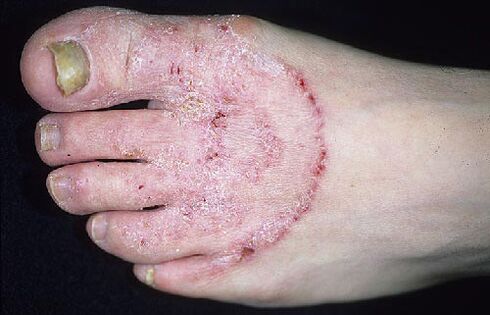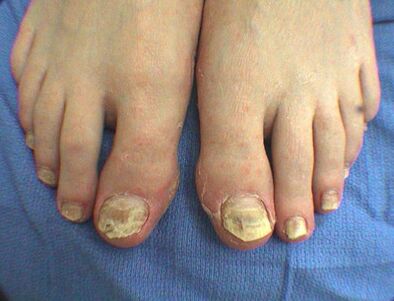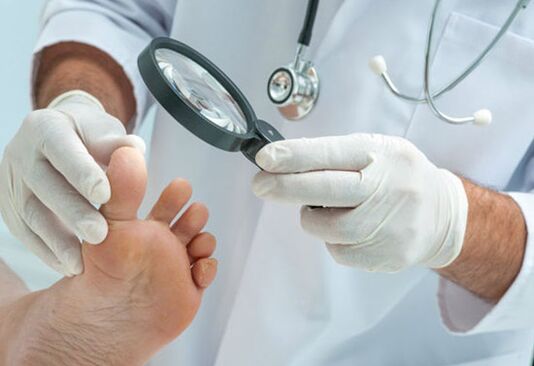The fungus of the nails (onychomycosis) is the most common disease in which the nails become yellow, they become fragile and thick, they are covered with cracks.In the initial stages, nail fungus symptoms are barely notable.The treatment of the disease is difficult due to deteriorated cell immunity.The disease continues slowly, without progressing the treatment and can accompany the patient all his life.

More often, fungi is detected in the nails in a man and people with weakened immunity.Patients with diabetes, obesity, faces with pathology of blood vessels and skin diseases are subject to disease.With high legs of sweating, there are more possibilities of fungal damage to the skin of the feet and nails on the legs.
The fungus can put on the nail dishes of the clothing, the shoes, from the manicure games, the carpets, the floor.Enter the nails through the skin of the skin and through the nail bed.It is a lot where it is warm and humid: in souls, bathrooms, changing rooms and swimming pools.In healthy people, the disease is rarely developed.
The cause of the disease
Onicycosis is caused by three species of fungi (one by one or in combination).Most cases of the disease are caused by fungi of the Trichophyton Rubrum type.Much less often: Trichophyton Interdigitale, Epidermophyton floccosum and microsporum and Aspergillus.
- The yeast fungi of the type of candida albicans always parasitize in the skin and nails.Taking antibiotics, contraceptives and a decrease in immunity can develop yeast infection.
- Moldo fungi often cause diseases in countries with tropical climate.
- Soil fungi live on the ground and cause onylomicisis only in some people.From person to person they are not transmitted.
What is the source of infection
- Diseases in family and friends can become a source of pathogens for you.
The fungus is transmitted to the family through use by a common towel, shoes, bedding, etc. - The fungus in the hands can become a source of nail disease and leg skin.
- In large quantities, the fungus lives in bathrooms, showers and swimming pools.
- The source of infection can be the patient's clothing and shoes, manicure games, carpets and floors.
That increases the risk of the disease
- The fungus of the skin of the feet.
- Reducing immunity.
- Family members suffering from fungal defeat.
- Elderly age.
- Diabetes.
- The presence of microtraumas and buppings.
- Increased leg sweating.
- Unknown and poor shoes of quality.
- The habit of walking barefoot in public places.
- Accommodation and work in a humid climate.
- In the long term with artificial nails.
Which affects the development and progression of onychomycosis
- General Health.
- Susceptibility to infection.
- The level of humidity and thermal background.
- The type of nail plate (fingertips grow more slowly).

Nail fungus symptoms
At the beginning of the disease, change the usual color of the nail.It becomes opaque.A gap in which the fungi appears between him and his bed.
The nail is painted in one of the colors: whitish, yellow, green and brown gray, to black.The yellow oblong stripes inside the nail and underneath are visible.Spots of different tones.
The thick nail and deforms the affected area.Horn masses gradually grow, avoiding drug penetration.
At first, there is also an increase in fragility, when the fungus affects the entire nail plate, it begins to crumble and collapse.When processing, a large amount of "garbage" is formed that consists of destroyed fragments and epidermis.There is often skin damage.
Foricomycosis forms
- Distal onylomycosis submarine.
- Lateral onychomycosis.
- White surface onicycosis.
- Proximal onylomycosis tray.
- Total distributing onicycosis.
Distal submarine and lateral onicycosis
This form of disease is the most common.Up to 90% of cases, its cause are the fungi of the genus Trichophyton Rubrum.The infection of the nail plate begins on the free edge of the skin affected of the foot.First, the nail bed is touched.The type of damage resembles a splinter or stained yellowish color.With the progression of the disease, the nail is thick and can be divided or separated from the skin.Distal submarine onychomycosis is difficult to treat.Use shoes cause discomfort.
White surface onicycosis
The second most common form of onychomycosis.In 90% of cases, the disease is caused by the genre of the genus Trichophyton Interdigitale, which affects only the upper layer of the nail plate, which is never thick and does not separate from the skin.Over time, its entire surface is released, such as chalk dust.The cure occurs rapidly.
Proximal onylomycosis tray
This form of onylomycosis is rare.The red trichophyte in the blood and lymphatic routes spread throughout the body.This is evidenced by the damage to the nail from the back (proximal) and the detection of the pathogen in the lymph nodes of the inguinal region and the secretion of the prostate gland.The disease is often recorded in infected HIV.The defeat begins with the skin in the area of the fold of the nail, which is thick.In addition, nail plate is involved in the process, which acquires a white opaque color.
Total distributing onicycosis
This form of the disease is a consequence of the progression of one or a set of types of the previous forms of onylomycosis.The nail plate is partial or completely destroyed.
Diseases with similar symptoms

Of all infectious diseases, onychomycosis is found in 50% of cases.Similar symptoms are found in the following diseases:
- Eczema.
- Soriasis
- Reuters syndrome.
- Daria's disease.
- Lican flat.
- Norwegian CarCE.
Diagnosis of nail fungus
To obtain information on what caused certain changes, you must consult a dermatologist to organize the procedure to diagnose the disease.The scraping of the affected part will be sent to the laboratory to clarify the causes of the disease.
The microscopy will identify the presence of a fungus, and planting in a nutrient medium will highlight the pure culture of the pathogen and determine the sensitivity to antimicotic medications.
Before starting treatment, it is necessary to identify the type of infection. Leg nail fungus is easier to warn.Examine feet and fingernails on your feet more frequently.The early treatment initiated will help to quickly achieve an improvement, reduce the feeling of discomfort and eliminate the cosmetic effect.

























